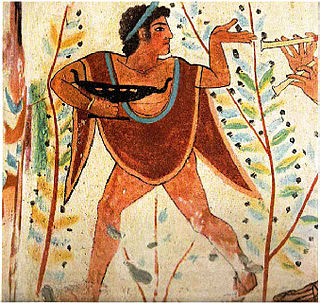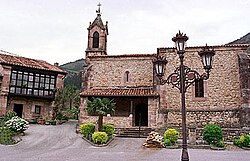
Flavius Romulus Augustus, known derisively and historiographically as Romulus Augustulus, was the Roman emperor who ruled the Western Roman Empire from 31 October 475 until 4 September 476. He is often described as the "last Western Roman emperor", though some historians consider this to be Julius Nepos. His deposition by Odoacer traditionally marks the end of the Roman Empire in the West, the end of Ancient Rome, and the beginning of the Middle Ages in Western Europe.
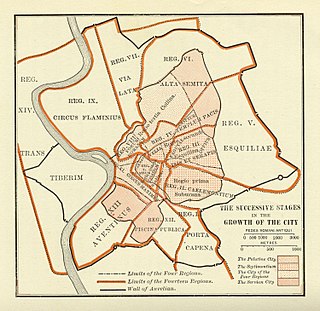
The Roman Kingdom, also referred to as the Roman monarchy, or the regal period of ancient Rome, was the earliest period of Roman history, when the city and its territory were ruled by kings.

Servius Tullius was the legendary sixth king of Rome, and the second of its Etruscan dynasty. He reigned 575–535 BC. Roman and Greek sources describe his servile origins and later marriage to a daughter of Lucius Tarquinius Priscus, Rome's first Etruscan king, who was assassinated in 579 BC. Servius is said to have been the first Roman king to accede without election by the Senate, having gained the throne by popular support; and the first to be elected by the Senate alone, without reference to the people.

The Etruscan civilization is the modern name given to a powerful and wealthy civilization of ancient Italy in the area corresponding roughly to Tuscany, south of the Arno river, western Umbria, northern and central Lazio, with offshoots also to the north in the Po Valley, in the current Emilia-Romagna, south-eastern Lombardy and southern Veneto, and to the south, in some areas of Campania. As distinguished by its unique language, this civilization endured from before the time of the earliest Etruscan inscriptions until its assimilation into the Roman Republic, beginning in the late 4th century BC with the Roman–Etruscan Wars.

The tale of the Founding of Rome is recounted in traditional stories handed down by the ancient Romans themselves as the earliest history of their city in terms of legend and myth. The most familiar of these myths, and perhaps the most famous of all Roman myths, is the story of Romulus and Remus, twins who were suckled by a she-wolf as infants in the 8th century BC. Another account, set earlier in time, claims that the Roman people are descended from Trojan War hero Aeneas, who escaped to Italy after the war, and whose son, Iulus, was the ancestor of the family of Julius Caesar. The archaeological evidence of human occupation of the area of modern-day Rome, Italy dates from about 14,000 years ago.

Veii was an important ancient Etruscan city situated on the southern limits of Etruria and only 16 km (9.9 mi) north-northwest of Rome, Italy. It now lies in Isola Farnese, in the comune of Rome. Many other sites associated with and in the city-state of Veii are in Formello, immediately to the north. Formello is named after the drainage channels that were first created by the Veians.

Dionysius of Halicarnassus was a Greek historian and teacher of rhetoric, who flourished during the reign of Caesar Augustus. His literary style was Atticistic — imitating Classical Attic Greek in its prime.
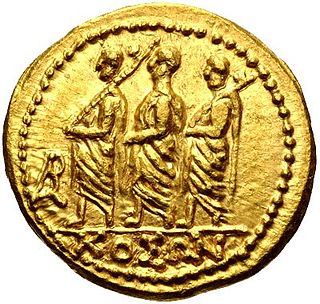
A lictor was a Roman civil servant who was a bodyguard to magistrates who held imperium. Lictors were used since the Roman Kingdom, and according to Roman historian Livy, the custom may have originated earlier, in the Etruscan civilization.
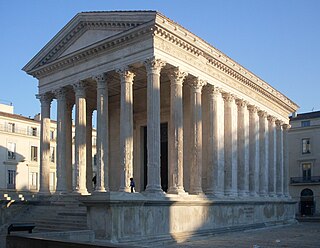
Ancient Roman temples were among the most important buildings in Roman culture, and some of the richest buildings in Roman architecture, though only a few survive in any sort of complete state. Today they remain "the most obvious symbol of Roman architecture". Their construction and maintenance was a major part of ancient Roman religion, and all towns of any importance had at least one main temple, as well as smaller shrines. The main room (cella) housed the cult image of the deity to whom the temple was dedicated, and often a small altar for incense or libations. Behind the cella was a room or rooms used by temple attendants for storage of equipment and offerings. The ordinary worshipper rarely entered the cella, and most public ceremonies were performed outside, on the portico, with a crowd gathered in the temple precinct.
The city of Rome, founded in a strategic location among a war-like people, needed to concern itself with military activity from the start. As Rome grew, its military needs changed. This article covers the military establishment of the Roman kingdom up to about 300BC.
The celeres were the bodyguard of the Kings of Rome. Traditionally established by Romulus, the legendary founder and first King of Rome, the celeres comprised three hundred men, ten chosen by each of the curiae. The celeres were the strongest and bravest warriors among the early Roman nobility, and were the bravest and most loyal soldiers in the army. The name of celeres was generally believed to have arisen from their celeritas, or swiftness, but Valerius Antias maintained that their first commander was named "Celer", perhaps the same Celer mentioned by Ovid as the foreman of the first fortification built around the Palatine Hill; it was he, rather than Romulus himself, who slew Remus after he overleapt the wall.

The King of Rome was the chief magistrate of the Roman Kingdom. According to legend, the first king of Rome was Romulus, who founded the city in 753 BC upon the Palatine Hill. Seven legendary kings are said to have ruled Rome until 509 BC, when the last king was overthrown. These kings ruled for an average of 35 years.

Romulus was the legendary founder and first king of Rome. Various traditions attribute the establishment of many of Rome's oldest legal, political, religious, and social institutions to Romulus and his contemporaries. Although many of these traditions incorporate elements of folklore, and it is not clear to what extent a historical figure underlies the mythical Romulus, the events and institutions ascribed to him were central to the myths surrounding Rome's origins and cultural traditions.

Etruscan art was produced by the Etruscan civilization in central Italy between the 9th and 2nd centuries BC. From around 600 BC it was heavily influenced by Greek art, which was imported by the Etruscans, but always retained distinct characteristics. Particularly strong in this tradition were figurative sculpture in terracotta, wall-painting and metalworking especially in bronze. Jewellery and engraved gems of high quality were produced.

Roman history has been among the most influential to the modern world, from supporting the tradition of the rule by law to influencing the American Founding Fathers to the creation of the Catholic church. Roman history can be divided into the following periods:

The Raeti were a confederation of Alpine tribes, whose language and culture may have derived, at least in part, from the Etruscans. From not later than ca. 500 BC, they inhabited the central parts of present-day Switzerland, Tyrol in Austria, the Alpine regions of northeastern Italy and Germany south of the Danube.

The Latins, sometimes known as the Latians, were an Italic tribe which included the early inhabitants of the city of Rome. From about 1000 BC, the Latins inhabited the small region known to the Romans as Old Latium, that is, the area between the river Tiber and the promontory of Mount Circeo 100 kilometres (62 mi) SE of Rome.
Titus is a Latin praenomen, or personal name, and was one of the most common names throughout Roman history. It was used by both patrician and plebeian families, and gave rise to the patronymic gens Titia. The feminine form is Tita or Titia. It was regularly abbreviated T.

Rionansa is a municipality located in the autonomous community of Cantabria, Spain.



